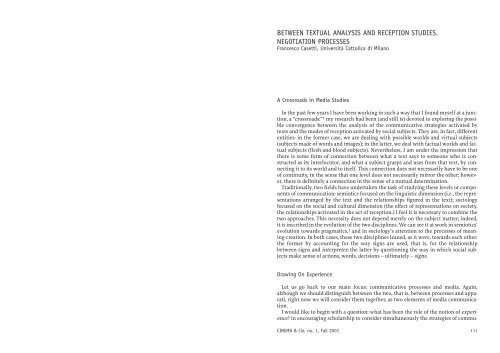rivista def ok - Current Issue
rivista def ok - Current Issue
rivista def ok - Current Issue
Create successful ePaper yourself
Turn your PDF publications into a flip-book with our unique Google optimized e-Paper software.
BETWEEN TEXTUAL ANALYSIS AND RECEPTION STUDIES.<br />
NEGOTIATION PROCESSES<br />
Francesco Casetti, Università Cattolica di Milano<br />
A Crossroads in Media Studies<br />
In the past few years I have been working in such a way that I found myself at a junction,<br />
a “crossroads:” 1 my research had been (and still is) devoted to exploring the possible<br />
convergence between the analysis of the communicative strategies activated by<br />
texts and the modes of reception activated by social subjects. They are, in fact, different<br />
entities: in the former case, we are dealing with possible worlds and virtual subjects<br />
(subjects made of words and images); in the latter, we deal with factual worlds and factual<br />
subjects (flesh-and-blood subjects). Nevertheless, I am under the impression that<br />
there is some form of connection between what a text says to someone who is constructed<br />
as its interlocutor, and what a subject grasps and uses from that text, by connecting<br />
it to its world and to itself. This connection does not necessarily have to be one<br />
of continuity, in the sense that one level does not necessarily mirror the other; however,<br />
there is <strong>def</strong>initely a connection in the sense of a mutual determination.<br />
Traditionally, two fields have undertaken the task of studying these levels or components<br />
of communication: semiotics focused on the linguistic dimension (i.e., the representations<br />
arranged by the text and the relationships figured in the text); sociology<br />
focused on the social and cultural dimension (the effect of representations on society,<br />
the relationships activated in the act of reception.) I feel it is necessary to combine the<br />
two approaches. This necessity does not depend merely on the subject matter; indeed,<br />
it is inscribed in the evolution of the two disciplines. We can see it at work in semiotics’<br />
evolution towards pragmatics, 2 and in sociology’s attention to the processes of meaning-creation.<br />
In both cases, these two disciplines leaned, as it were, towards each other:<br />
the former by accounting for the way signs are used, that is, for the relationship<br />
between signs and interpreter; the latter by questioning the way in which social subjects<br />
make sense of actions, words, decisions – ultimately – signs.<br />
Drawing On Experience<br />
Let us go back to our main focus: communicative processes and media. Again,<br />
although we should distinguish between the two, that is, between processes and apparati,<br />
right now we will consider them together, as two elements of media communication.<br />
I would like to begin with a question: what has been the role of the notion of experience<br />
3 in encouraging scholarship to consider simultaneously the strategies of commu-<br />
CINEMA & Cie, no. 1, Fall 2001<br />
111


